Introduction
Planning to grow a backyard vineyard? Want your dream of making wine come true? Now is the time to get started! Springtime is the best to plant grapes to enjoy bountiful harvests for years to come.
Grapes are not the easiest crop to grow, however once established they can produce for decades. Grapes are one of the most versatile fruits available in different varieties- from seedless to the most plump and juiciest fruits. Which is not only just for eating but can be preserve and stored, for jam and jellies, for cooking and if you are feeling adventurous you can even make your own wine out of it. They can also beautify the landscape as well as with their large sculpted leaves and colorful ripening fruit.
Types of grapes:
Grapes can be broken down into three basic varieties: European, American and Muscadine. American varieties like concord, labrusca, and Mars are great for jams and jellies. They are more tolerant to cold weather. European selections are more known for wine making. Muscadine grapes have a robust, musky flavor excellent for fresh eating, juice, jelly or wine. They best grown in warm hum id climates
How to grow a vineyard in your backyard
Having a small-scale vineyard is different than growing few clusters of table grapes though the practices are similar. The process of growing a vineyard is initially labor intensive, you’ll need to research and to have required resources; you’ll have to choose a location; prepare the soil; put the structure in place that will support the vineyard, but if you follow these steps with great care, the end result will be more than worth it.
This article will be a guide for you to learn the basic functionality and vocabulary and letting you loose to do your own research as well. Following are the steps to grow a vineyard in your own backyard.
Planning:

The most important elements for planning a vineyard are research and resource. There are many books available in the market that can help you in planning and growing a vineyard or there are even numbers of resources available in the internet where you can just Google it and find your answer. However, spending time and learning from the local grower will be more fruitful. Learning what obstacles they have faced and what tricks they have learned proves more helpful and handy for aspirant growers. Also, a visit to your local extension office also will be a plus point as they will have the necessary information and tips for planting a home vineyard. on types of grapes that grow best in your area.
In planning your vineyard, there are lots of considerations –
- selecting the sites, size and exposure
- preparation of the soil
- deciding if you plan to irrigate
- plan a trellising system
- choosing a row and vine spacing scheme
Sites, soil and exposure:
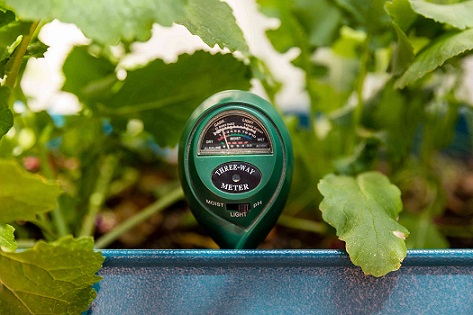
Despite of having over 10,000 varieties, all grape variety requires the same thing, i.e., full sun. Make sure the sites you selected for your vineyard gets 8 hours of sunlight per day or at least has morning sunlight. This will help your grape to grow well and produce sweet, full-flavored fruits.
The best soil type for growing grapes is well-drained soil with loamy texture. They like moisture, but have no likings of soggy roots. Before any planting begins, dig out all weeds and mixed the soli with at least two inches of compost or other high quality organic compost. Make sure the pH level of the soil has 5.6 to 6.2 pH. If the soil tends to be acidic, use light application of lime or wood ashes to balance the soil pH level.
Trellising and pruning
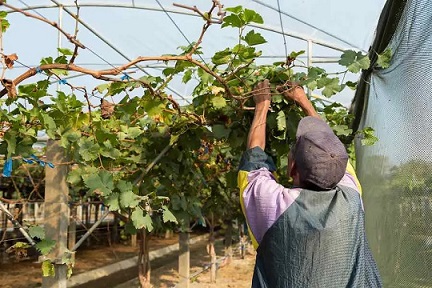
Maximizing productivity and preventing disease goes a long way when the trellis design and pruning practices matches with natural growth habit of your chosen grapes. For example, Concord grapes and labrusca varieties grow best on a high trellis or arbor. Muscadine grapes produced best on an overhead rectangular trellis, also called as X trellis. Two-tiered trellis is best preferred for most table grapes and wine grapes as they produce upward-facing shoots. Aggressive pruning table grapes and wine grapes are required.
Pruning is an important part of maintaining your grapevines especially during the first year, which should be done with great caution. Pruning grapes are best during late winter, before the buds begin to sprout.
Irrigation and vine spacing system
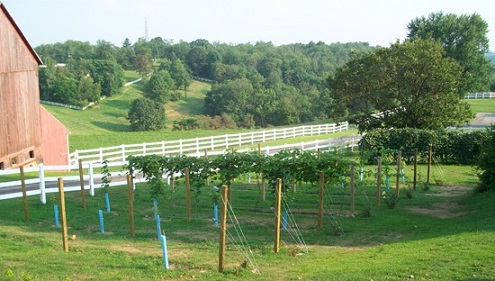
Grapevine need to be watered regularly. A drip irrigation system is the most effective and effective way of delivering the right amount of water to the roots at the right time. Thus, preventing from problems, like pest and diseases.
Remember to give enough personal space while planting grapevines. For instance a minimum spacing of eight feet between rows with a sturdy durable trellis installed during the planting time.
Harvesting the grapes
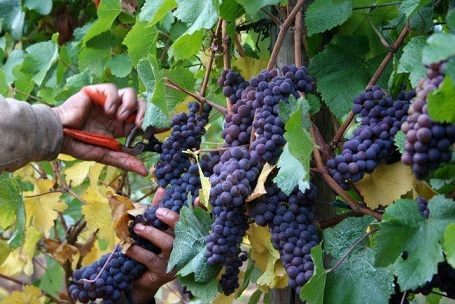
The flavor is the best way to know if your grapes are fully ripe and ready to be harvested. If they have their sweet flavor they are ready. And remember the older your vines get, the more grapes you’ll yield. A three-year-old vine may yield upto 5 to 10 pounds of grapes, and mature vines about 30 pounds. For wine making it takes upto 40 pounds for 12 bottles of wine.
Steps for planting grapevines:
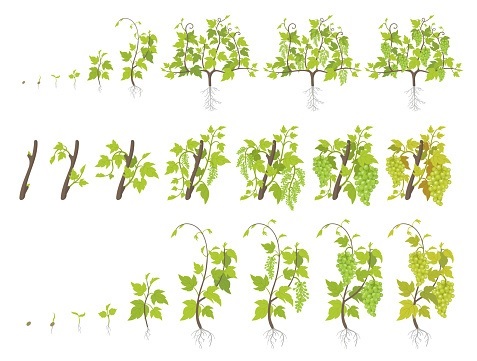
Following are the steps to plant a grape vine.
- Start by digging a 10 to 12” diameter hole about 12inches deep. Fill the bottom about 6 inches of the hole with topsoil.
- Place in your vines gently into the hole, and throw on a few more inches of soil, press down this layer.
- Now, finish with the last bit of soil, leave the top layer loose, and water the vines.
- Since grapevines need something to grow up, install a trellis system or you can also plant them against an existing fence (remember grapevines can get quite heavy so always choose something well constructed and sturdy).
- Cover the baby vines with mesh netting to protect them from the critters. Finally, add mulch around the bottom/ base of the vines to distribute moisture evenly.
Pests and diseases:

To get good and abundant harvest you need to be very cautious about preventing your grapevines from pest and diseases. North American grape varieties are mostly diseases resistant however European variety is prone to disease. Some common pests that hamper the growth of your grapes are:
- Downy mildew- You can treat it with fungicide, and to stop it from spreading you can protect your grapes from too much moisture.
- Powdery mildew- fungicide and silicon can be used for treating powdery mildew.
- Aphids- Neem oil or you can also use diatomaceous earth for treating against these insects.
- Japanese beetles- you can remove this insect by applying neem oil or handpicking or row covers.
You can visit your agricultural extension office as they will also have more information and tips for you to deal with pest and disease. [s]
Bottom Line
Growing grapes is not complicated as it seems, however it takes time and effort. When you have learned to master the technique to grow grapes, in the next few years you could be growing your own vineyard to the growing your own wine. Learn, grow, inspire and share the stories of your backyard or home vineyard. Wish you all the luck in your journey as an aspiring grape grower!

